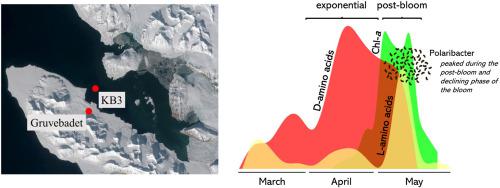Atmospheric Environment ( IF 5 ) Pub Date : 2021-05-06 , DOI: 10.1016/j.atmosenv.2021.118458 Matteo Feltracco , Elena Barbaro , Clara J.M. Hoppe , Klara K.E. Wolf , Andrea Spolaor , Rose Layton , Christoph Keuschnig , Carlo Barbante , Andrea Gambaro , Catherine Larose

|
Primary biological aerosol particles and microorganisms are ubiquitous in the atmosphere. Investigations of airborne chemical markers and microbial communities are critical for identifying sources, transport and transformation processes of aerosols. One potential major source of airborne chemical compounds and microbial communities (e.g. L- and D-amino acids, Flavobacteria) could be related to phytoplankton blooms that occur during the spring season in Arctic fjord systems. Here, we conducted a field study in a polar environment to investigate the occurrence in coarse and fine particles of water-soluble compounds (major ions, carboxylic acids and free L- and D-amino acids) and airborne bacterial communities in aerosol samples. The sampling was conducted with a 6 day sampling frequency at the Gruvebadet observatory, close to Ny-Ålesund (Svalbard Islands). Glycine, D-amino acids and C4- organic acids increased during the exponential phase of a marine bloom that occurred in Kongsfjorden and started to drop at the beginning of the main-bloom phase. On the other hand, Polaribacter together with free L-amino acids overlapped with the Chlorophyll a peak and the subsequent decline, and thus might constitute a useful marker for the main-bloom phase.
中文翻译:

空气传播的细菌和微粒化学物质捕获了北极峡湾中浮游植物的水华动态
主要的生物气溶胶颗粒和微生物在大气中无处不在。空气中化学标记物和微生物群落的调查对于确定气溶胶的来源,运输和转化过程至关重要。空气中的化学化合物和微生物群落(例如L和D氨基酸,黄杆菌)的一种潜在主要来源可能与春季在北极峡湾系统中发生的浮游植物开花有关。在这里,我们在极地环境中进行了田野研究,以调查在气溶胶样品中水溶性化合物(主要离子,羧酸以及游离的L和D氨基酸和游离氨基酸)在粗颗粒和细颗粒中的发生情况。采样是在Gruvebadet天文台以6天的采样频率进行的,靠近Ny-Ålesund(斯瓦尔巴群岛)。甘氨酸,D-氨基酸和C4-有机酸在Kongsfjorden发生的海洋水华的指数阶段增加,并在主花期开始时开始下降。另一方面,极地细菌与游离的L-氨基酸一起与叶绿素重叠一个峰和随后的下降,从而可能构成主相盛开的有用标志物。



























 京公网安备 11010802027423号
京公网安备 11010802027423号